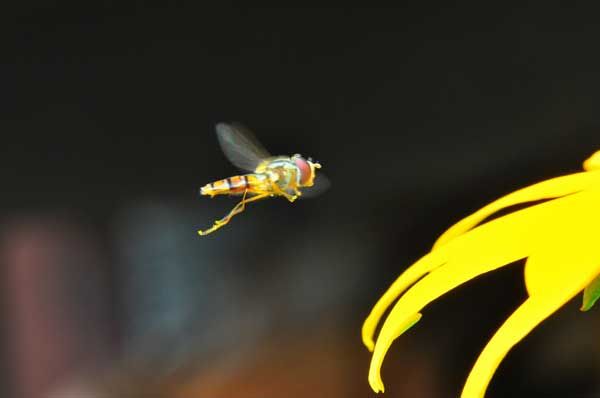Fruit Flies Use Edges to Set Cruise Altitude

Fruit flies make lots of flight decisions while circling a rotten banana, including how fast to hover and how high to fly.
Now, a new study using a 3-D virtual environment reveals that horizontal edges are the flies' key clue when deciding on their altitude.
The findings could be used to design robots capable of flying like bugs.
By capturing the flies' flight patterns with video, researchers from the California Institute of Technology found that the insects ignored visual cues, such as how fast the ground appeared to be moving when picking an altitude. Instead, the flies preferred to fly parallel to horizontal edges of objects, even shifting to follow the edges if they moved.
Virtual reality for flies
Fly flight has long been studied both as a model for how flying creatures use visual information to wheel around in three dimensions and as inspiration for flying robots. Prior to this study, researchers theorized that fruit flies picked their altitude using something called optic flow.
According to the optic flow theory, fruit flies watch the ground, seeing how fast it seems to move. Things farther away look slower, much like a far-off building doesn't seem to move as you drive past it on the highway, while nearby fence posts fly by. The flies chose their preferred speed, the theory went, and made adjustments to keep it constant.
Sign up for the Live Science daily newsletter now
Get the world’s most fascinating discoveries delivered straight to your inbox.
To test this and other theories, CalTech bioengineer Michael Dickinson and his colleagues built a 5-foot (1.5-meter-) long tunnel surrounded by cameras. Computer projectors "paint" the walls and floor of the tunnel with visual stimuli.
To test the optic flow theory, the cameras locked on to a fly's flight. Within milliseconds, the computer projectors responded by projecting alternating black-and-white lines on the floor of the tunnel. The lines moved at the same speed as the fly, creating the impression for the insect that even though its wings were beating, it wasn't moving through space.
If the optic flow theory were true, the flies should have immediately dropped down, trying to get the ground to speed up. But they didn't.
"We were sort of scratching our heads like, 'Well, why isn't this working?'" said Andrew Straw, a CalTech research fellow and co-author of the new study. "So we kept testing it and testing it."
The flies could clearly perceive the messed-up ground, because they changed their speed to try to compensate. But no matter how many times the researchers ran the experiment, the flies didn't change altitude.
In previous fly experiments, Dickinson had noticed that fruit flies prefer to land on the tops of objects. Perhaps, he thought, fruit flies are attuned to horizontal edges.
The team tested the idea by projecting black along the upper or lower half of the tunnel walls, creating an edge. Sure enough, the flies hovered happily alongside the line. Then the researchers tried altering the patterns of the floor again, this time with the horizontal edges on the walls. No matter how they slowed or sped up the patterns on the ground, the flies stuck with the edges.
Insect-inspired robots
The researchers don't know how flies use edge information in the real environment, where horizontal edges abound. Perhaps they pick whatever edge is the closest, or perhaps they come up with some sort of average. The team now plans to study how the flies integrate edge information with other visual information to pick flight plans.
The research helps unveil the mysteries of insect flight and cognition, but it may have practical implications for humans, as well.
"There are a lot of groups around the world that are trying to develop small insect-size robots or bird-size robots that, like birds and insects and bats, can fly autonomously — just using sensors," Dickinson said.
Using the flight mechanisms discovered by Dickinson and his colleagues, engineers could easily make computational models that could eventually be used to steer autonomous robots, Dario Floreano, a bio-robotics researcher at the Swiss Federal Institute of Technology, told LiveScience. Floreano, who was not involved in the study, called the findings "very important."
The researchers published their results in the journal Current Biology.

Stephanie Pappas is a contributing writer for Live Science, covering topics ranging from geoscience to archaeology to the human brain and behavior. She was previously a senior writer for Live Science but is now a freelancer based in Denver, Colorado, and regularly contributes to Scientific American and The Monitor, the monthly magazine of the American Psychological Association. Stephanie received a bachelor's degree in psychology from the University of South Carolina and a graduate certificate in science communication from the University of California, Santa Cruz.











